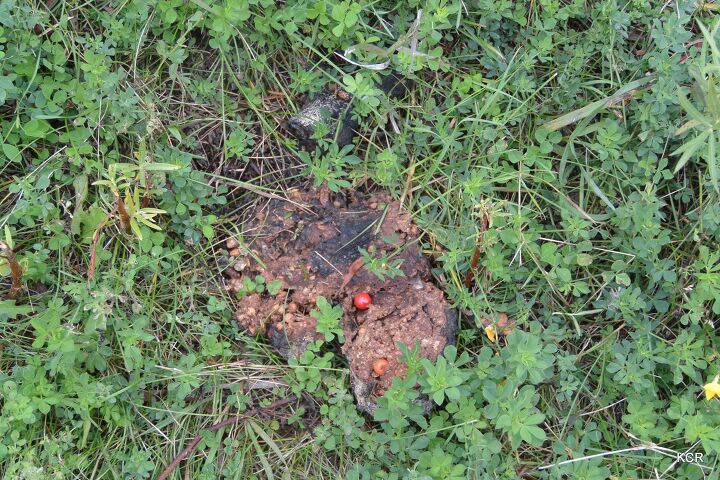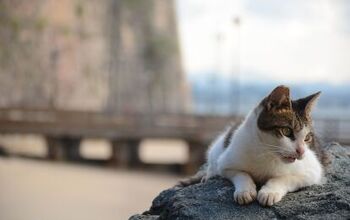Call Of The Wild: What Animals To Watch Out For While Hiking With Your

I have had a few close encounters of the wild kind while out on the trails with my dogs. I think the most scared I ever was when I was hiking in the Yukon. Way out on the open Tundra, I was having a picnic lunch and watching a herd of caribou down across a valley. There were hundreds of caribou and I could hear them as they ran across the tundra. Once my lunch was over and the caribou were gone, I started to retrace my steps back down the hills, across the tundra, and to my truck.
Related: The Hunt For Antler Sheds
It was at that moment that my dog Belle stopped and sniffed something on the ground. Something huge, round, and brown. Fresh poop. From a brown bear. This smelly and scary package was on the same path that I had walked not an hour before. That meant the bear was close, and I had no idea where it was. I kept my eyes open, my dogs on a leash, as I sang at the top of my lungs. That way, even though I had no idea where the bear was, it knew where I was, and I hoping it wanted to avoid me (because of my off-tune crooning). The incident really spooked me. I had my dogs on leash, bear bells were being worm by everyone, and I was alert and ready with my bear spray strapped to my side. Yep – I guess you could say that I was prepared for a bear that trip!
Related: Adventures In Canine Canoeing
I have seen plenty of animals while out with my dogs. Most of the encounters have been more on the “Oh wow” side, than the “Oh wow, that was close!” situation. Even though they may sound cool or exotic to spot on the trail, there are plenty of animals that you want to avoid when out with your dog. Here are some tips, gained from my experiences on how to avoid skirmishes with wildlife when out with your dog in the woods.
Bears
Bears, whether they be black or brown (grizzly), you’ve got to be smart when in bear country. Most bears want to avoid trouble, and to most bears, people mean trouble. If there are bear in your area, the best way to keep safe is by ensuring your dogs are on leash in the bush.
When first encountering a bear, most dogs have a huge sense of bravado – all teeth, snarls and hackles as they run towards the bear. You might be thinking: “Awesome, my dog just saved my bacon!” That’s until the bear takes the defense, and your dog soberly rethinks his plan of attack and decides to bolt back the way he came. And he can run faster than you.
It’s at the moment that your dog goes from a hero to a liability. He’ll turn tail and run back to the safety of Mom or Dad, with an angry bear hot on his heels. The best way to control your dog in bear country is with a leash.
My dogs really hate bears. It might be that because anytime I have seen a bear I put on a big show – yelling, stomping and acting downright scary. Usually, if a bear knows you are there, they take their leave before you even realize they’re there. Bears are pretty anti-social when people are in the area.
Cases of predatory black bear attacks are extremely rare. If you are hiking in a group, talk to each other, sing, make lots of noise. Let the bears know you are coming. If you are hiking alone, you may consider a bear bell, or belt out some of your favorite songs.
Be on the lookout for fresh signs of bear. Just a few things to keep an eye out for include prints, turned-over rocks, ripped up stumps, claw marks on trees, and of course, bear poop. If you come across any of these bear signs, start making noise and leave the area from the same direction you came in. Alert any other trail users you come across of fresh signs of bear in the area. Most bears want to avoid people, but you should take them seriously and treat these animals with respect. With enough warning and space, you’ll avoid any problems.
Wolves
Wolves are another animal that ranks high up on the food chain, and on the plus side, they want to avoid any trouble with humans. It’s rare to see a wolf out in the woods; they are fast, smart and weary of us. Healthy wild wolves will not attack humans and will avoid you at any cost.
Wolves and dogs are often considered cousins, but dispel any warm and fuzzy thoughts you have of a happy family reunion. When wolves and dogs cross paths, the wolves either regard the dog as completion and kill it, or see it was food, and eat it. Again, when you’re in wolf country, keep your dog on a leash.
We spend lots of time in wolf territory, and have only caught glimpses of wild wolves, but their signs are everywhere. Keep an eye on the trail for wolf signs, as wolves will defecate on the trail to mark their territory. Wolf prints look similar to a dog’s, but are much larger, and are never accompanied by a human’s foot prints. If you spot wolf signs or know you are in wolf territory, keep your dogs on a leash, and under control. The wolves will have fled long before you see them.
Porcupines
Oh, the prickly porcupine! It may not the world’s smartest creature, but it’s certainly one of the most adapted to discouraging predators. Porcupines are slow; just their speed alone is enough to make some dogs think they can take unassuming and interesting animals on! But watch out – as soon as the dog gets close and spooks the porcupine, he’s treated with a face full of quills.
It sounds awful and it’s painful and dangerous for your dog! But your dog will be safe from porcupines, because you know to keep your dog under control and on a leash. If you forgot the golden rule and let your dog run leash-free, or let your guard down, you’ll need to remove the quills quickly. If you can’t remove them on your own, don’t cut them. Leave them in place and get to a vet ASAP. It might sound cruel to leave them in, but a full quill is easier for a vet to work with. Quills need to be attended to quickly – if they are left in, they’ll work their way deeper into the tissue.
Be warned that some dogs don’t learn from their mistakes – one tangle with a porcupine is not enough. These pooches may be more stubborn than smart, or have more brave than brains, and you can bet that they’ll seek out a chance for revenge with the next porcupine they see. Just one more reason to always keep your dog on a leash during hikes!
Moose
Two things you need to know about moose: 1. They are VERY large; and 2. Are preyed upon by wolves. Do you think that an animal that has to stand up to a pack of wolves will be an easy target for your dog to tangle with? The good thing is that most moose will leave an area when they know that people are dogs are about. But there are moose that won’t – these are the ones you need to worry about. If there is a moose on the trail, turn around while still keeping an eye on it, and keep your dog under control. A moose won’t go out of its way to harm your dog, but it will certainly defend itself. With its powerful legs and sharp hooves, your dog doesn’t stand a chance against an enraged moose. Moose are excellent swimmers, so getting into the water or being in a canoe doesn’t guarantee that you won’t encounter one of these impressive-looking animals. We had a moose charge the truck once – man, he had a nasty temper! Respect them, give them space and just don’t mess with moose.
Skunks
Another well-equipped animal that’s ready to get into a scape with your dog is the skunk. Knock on wood – my dogs have never sprayed by a skunk. You’re more likely to find skunks closer to civilization where they can help themselves to food and garbage than out in the words. But you’ll spot them in urban forests, parks and campgrounds – all great sources of food for our smelly friends. Skunks aim their spray with surprising accuracy and have quite a range. If you happen to surprise a skunk, you may be lucky enough to receive a quick warning sign of stomping feet. If you see a skunk do this, turn around and RUN! An older, bigger skunk will be more likely to leave you alone… but the same can’t be said for the smaller, younger, inexperienced skunks. These little fellas are more prone to shoot first and ask questions later.
Coyotes
Conflicts with coyotes are becoming more common place. As we encroach onto their territory, these adaptable animals are learning to adjust and live with us. Coyotes are opportunistic scavengers, meaning they will make a meal of nearly anything they can get their paws and jaws on. Unfortunately, this sometimes includes our beloved pets. Coyotes will go for an easy meal. A single coyote will snatch a small dog, while a group of coyotes will attach a larger dog. Always keep your dog on a leash and under your control at all times. I’ve had numerous encounters with coyotes, but none have ever resulted in tragedy. However, there have been a few times I’ve had close calls with a brave coyote that stood its ground for a few heart-pounding seconds (that felt like hours). It took lots of waving, gesturing and aggressive posturing from my part to convince the coyotes to leave us alone.
Snakes
Snakes fall firmly into the category of animals that most want to be left alone. With enough warning, the majority of snakes (both venomous and non-venomous) will leave dogs alone. Every snake has its own specific behaviour patterns and preferred habitat. When playing or walking with your dog in snake country, keep your dog close by on a leash and make sure the two of you are brushed up on your obedience training. Running across a snake is different than running across a bear or a moose. You usually get a bit more warning with larger animals, and be able to spot it from a farther away. When it’s a camouflaged snake laying on the trail, there is a chance that your dog will see it before you do. Keep your eyes open and watch that your dog doesn’t stick his nose into a snake’s business!
A Few Parting Words
Wild animals, for the most part, want to be left alone. Know the area you are exploring and learn about its natural inhabitants before setting out on your hike. Trail heads, ranger stations and websites specific to the area you are traveling are great sources of information that can help you and your dog can avoid a potentially dangerous wildlife encounter. Minimize your risk by keeping your dog on a leash and under control at all times. As well, updated distemper and rabies shots will also go a long way to keeping your dog healthy, should he come into contact with a wild animal. Remember that most animals are active at dawn and dusk, so planning around these times will reduce the likelihood of having a wild animal encounter.

Kevin Roberts lives for adventure. Together with his pack of rescue dogs and his husband, he spends as much time outdoors as possible. Kevin lives by the motto: "Get outside and play with your dogs!
More by Kevin Roberts





























